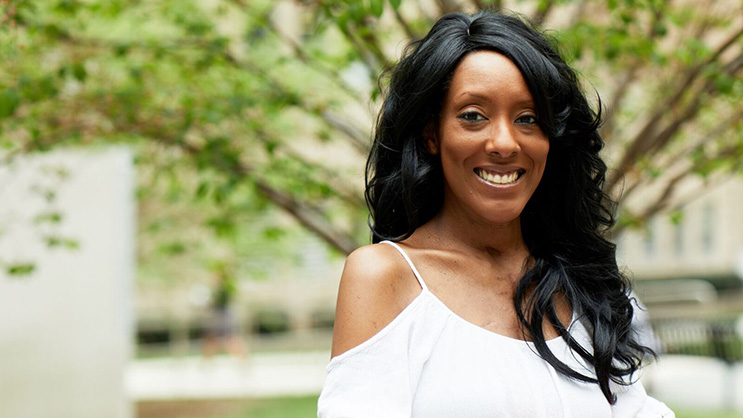
Cherie Aimée plans to do a lot of good for a lot of people. And she’ll get the chance, thanks to a mechanical assist device that took over when her heart stopped beating and served as a bridge to transplant.
In her twenties, Cherie travelled all over the country as a coder for tech startups. A decade later, she branched out into advertising, marketing and branding, launching her own firm. The work was demanding and the deadlines fierce.
At the height of her success, Cherie was diagnosed with Hodgkin’s lymphoma and underwent six months of chemotherapy. Afterward, her focused changed. She joined the Board of Directors for a non-profit that was treating children with HIV in South Africa. “When I recovered from my cancer, I wanted to help others,” she said, “And so I gave this organization everything I had.” One day, however, Cherie felt faint, and her arms grew heavy. Her husband rushed her to the hospital in Danbury, CT and she flat-lined minutes later in the emergency room.
Cherie’s cardiologist put her on ECMO (extracorporeal membrane oxygenation), a machine that took over for her heart and lungs and then called the heart transplant team at NYP/Columbia. Within hours, an ambulance arrived and Cherie was soon in the care of Drs. Yoshifumi Naka, Hiroo Takayama, and Paolo Colombo. The surgeons put Cherie on an LVAD, a circulatory assist device that would keep her alive until they could find her a donor heart.
When she came home from the hospital, Cherie went into activist mode. “I couldn’t just sit there,” she said. “While I was getting stronger, I looked into the options for wearing what was essentially a small computer designed to keep me alive.” Within a short time Cherie had produced an Amazon bestseller in the self-help medical category—How to Rock an LVAD like a Fashionista—with tips on how to find a stylish backpack with the right compartments to hold the device and its extra battery. She also started learning more about the transplant process.
Cherie has high praise for the patient education she received at Columbia in preparation for her transplant. “Patients who had LVADs and heart transplants mentored those of us who were on the waiting list,” she says. “They listened to our fears, and answered all our questions. I had no idea how many advances had been made in circulatory assist devices, or that Columbia did so many of transplant surgeries each year. We also learned about the medicines we’d need to take right after the transplant, and how soon we’d be able to taper off them. It was beautiful to see the level of support provided for my husband as a caregiver.”
In 2014, Cherie received a new heart. “By then everyone on the staff had become my family—from the doctors and cardiac ICU nurses to the security guards and the staff who cleaned my room. The care at Columbia was more than exceptional.”
“Having a life-threatening illness changes you,” she adds. “One day I was enjoying my life with friends and family—while building a thriving business. The next I was in an ER with no heartbeat. LVAD patients are some the most resilient people on the planet. When there’s a machine keeping you alive, you’re in spiritual boot camp. You learn to strengthen your mind and hone your sense of purpose.”
Since her transplant, Cherie has been the subject of a Japanese television documentary, and featured by the leading morning news show in Australia, ABC7 New York, and Forbes magazine. She gives inspirational talks about staying strong in the face of adversity and has joined the Transplant Forum at Columbia, counseling patients who are waiting for a donor heart. “When I flat-lined,” she says, “I had a near-death experience. I know that I was put here for a reason. Thanks to my transplant, I have another chance at helping others and at giving back.”
